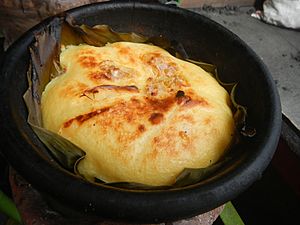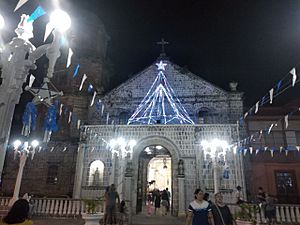Simbang Gabi facts for kids
Quick facts for kids Simbang Gabi |
|
|---|---|

Simbang Gabi Mass at the Saint Joseph Parish Church of Las Piñas
|
|
| Also called | Misa de Aguinaldo Misa de Gallo (for the last Mass observed in Simbang Gabi) |
| Observed by | Filipino Catholics |
| Significance | Christmas season |
| Observances | Novena |
| Begins | December 16 |
| Ends | December 24 |
| Date | Lua error in Module:Wikidata at line 132: attempt to index field 'wikibase' (a nil value). |
| Related to | Misa de Gallo Nochebuena Christmas |
Simbang Gabi (/sim.ˈbʌŋ.ˈɡʌ.ˌbi/; Filipino for "Night Mass") is a special nine-day series of Masses. Filipino Catholics attend these Masses to get ready for Christmas. It is like the nine early morning Masses in Puerto Rico called Misa de Aguinaldo.
In the Philippines, Simbang Gabi happens every day from December 16 to 24. These Masses are held very early, usually from 3:00 a.m. to 5:00 a.m. On Christmas Eve, the last day of Simbang Gabi, the Mass is called Misa de Gallo. This means "Rooster's Mass" in Spanish. Simbang Gabi is a very important part of Philippine culture.
Contents
History of Simbang Gabi
Simbang Gabi started a long time ago, when Spain ruled the Philippines. It began in 1669. Farmers in the Philippines used to start work before the sun came up. This helped them avoid the hot midday sun in the fields. Priests saw this and decided to hold Mass early in the mornings. This was different from other Spanish-speaking countries, where these special Masses were usually held in the evenings. This beloved Christmas tradition became a unique part of Philippine culture. It also became a symbol of sharing and community.
Why Early Morning Masses Started
The Philippines is a country known for its farms. Many people worked in rice, coconut, and sugarcane fields. These farmers worked hard all day. They took a short break at noon when it was too hot.
When the Christmas season began, it was common to have special prayers called novenas in the evenings. But the priests noticed that people were very tired after working all day. Even so, they still wanted to attend church. To help them, the priests decided to hold the Masses very early in the morning. This way, people could go to church while it was still dark, before they had to go to work in the fields.
Delicious Food After Mass

In the past, people would bring things like rice, fruits, vegetables, and fresh eggs to offer at Mass. The Church would then share these items with everyone after the service.
Today, after Simbang Gabi Mass, Filipinos often buy and eat special holiday foods for breakfast. These treats are sold right outside the church. Two very popular dishes are Bibingka and puto bumbong. Bibingka is a type of rice cake cooked with heat from above and below. Puto bumbong is a steamed purple rice pastry. It is often served with butter, grated coconut, and brown sugar. People usually drink tsokolate (hot chocolate made from local cacao) or salabát (ginger tea) with these treats.
Many other local foods are also available. You can find suman and other rice pastries cooked fresh. Sweets like Latík and yema are sold for children. Biscuits such as uraró (arrowroot cookies), barquillos, lengua de gato, and otap (ladyfingers) are also popular. Strong coffee called Kapeng barako from Batangas, hot tsokolate, or salabat are the main drinks. You might also find soups like arróz caldo (rice and chicken porridge).
These rice-based foods were traditionally served to fill the farmers' stomachs. Rice was a cheap and important food. The pastries gave colonial Filipinos lots of energy (carbohydrates) for their hard work in the fields.
How Simbang Gabi is Celebrated Today

The Mass usually starts at four o’clock in the morning. A long time ago, Pope Sixtus V said that Mass should be held before sunrise during harvest season. This was so farmers could go straight to their fields after church.
For Simbang Gabi, the special color for the Mass is white. For other Masses during the day, the color is violet because it is still the Advent season. If Simbang Gabi falls on a Sunday, the prayers and readings are from the Sunday service, and the color is violet.
Filipinos celebrate this Mass with great respect. The Gloria song is sung, which is usually not allowed during Advent. Simbang Gabi is also celebrated in shopping malls, often in open areas. However, Cardinal Luis Antonio Tagle has said that Masses should only be held in malls if they have their own chapel.
Some churches also hold Simbang Gabi in the evenings, from December 15 to 23. These are sometimes called "anticipated Simbang Gabi." However, these Masses use the readings and prayers meant for that specific day, not for the next day.
Many people believe that if you complete all nine days of Simbang Gabi, God will grant a special wish you make.
Like a Spanish tradition of lighting small oil lamps on Christmas Eve, Filipinos decorate their homes with paról. These are colorful star-shaped lanterns. People believe they were first used by churchgoers to light their way to church in the early morning. They also represent the Star of Bethlehem. Paróls are still very popular Christmas decorations in the Philippines. They are as important as Christmas trees are in Western countries.
Some groups celebrate Simbang Gabi in the old way, using the Traditional Latin Mass. They use candlelight and old Filipino songs for the Mass. This helps people experience how Simbang Gabi was celebrated long ago.
See also
- Christmas in the Philippines
- Rorate Coeli

